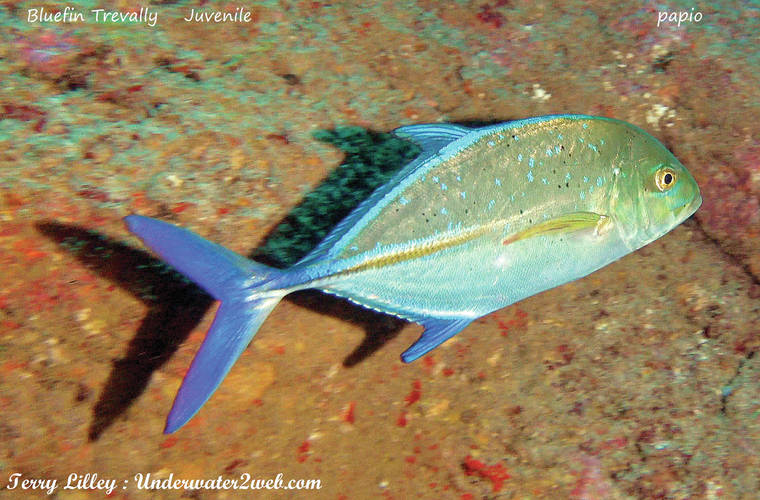‘Omilu is in the jack family of fish, and is one of the most-important game fish for the nearshore Hawaiian fishing community. It is also a very-beautiful and powerful fish to watch while out scuba diving, with its fluorescent blue-and-green colors. They are a very active and fast fish, and always on the hunt. Adults grow up to three feet long, and they are one of the most important predators on the Hawaiian coral reefs. They eat small fish and can chase them down with great bursts of speed. The more ‘omilu on a reef system usually means a healthier coral reef.
‘Omilu is in the jack family of fish, and is one of the most-important game fish for the nearshore Hawaiian fishing community. It is also a very-beautiful and powerful fish to watch while out scuba diving, with its fluorescent blue-and-green colors. They are a very active and fast fish, and always on the hunt. Adults grow up to three feet long, and they are one of the most important predators on the Hawaiian coral reefs. They eat small fish and can chase them down with great bursts of speed. The more ‘omilu on a reef system usually means a healthier coral reef.
Large ‘omilu often hunt in pairs, and they change directions very quickly, surprising small fish before they can hide in the coral or lava cracks. Sometimes these big fish will hunt in such shallow water that their dorsal fin sticks above the surface and they are mistaken for sharks by people on shore or snorkeling. This large fish also hunts with moray eels. Some fish species often hunt with other fish species, and the moray eels hunt deep in caves, scaring fish out into the open where the ‘omilu grab them. The bluefin trevally hovering up above the reef often will scare fish into cracks and caves where the eel is waiting to grab them. When ‘omilu and the eel want to hunt together they will approach each other and rub noses, indicating the hunt is on.
Bluefin trevally are often mistaken for the large giant trevally or ‘ulua. The major difference is color, as the ‘ulua are solid grey and lack the colorful blue fins. But when both species are young they may all hang out together in one large school of 20 to 50 fish. The small ‘ulua or ‘omilu are called “papio,” as they have a different Hawaiian name then the adults. When a fisherman catches a papio from shore he or she may be catching a small ‘omilu or a small ‘ulua, as they are hard to tell apart when they are young.
You can see the ‘omilu in action in the underwater educational movie “The World’s Guide To Hawaiian Reef Fish” at underwater2web, and also learn all about Hawaiian reef fish on the nonprofit Reef Guardians Hawai‘i website.
•••
Terry Lilley is a marine biologist living in Hanalei and co-founder of Reef Guardians Hawai‘i, a nonprofit on a mission to provide education and resources to protect the coral reef. To donate to Reef Guardians Hawaii go to reefguardianshawaii.org.

Subscribe today for unlimited access.
Already a subscriber?
Login
Not ready to subscribe?
Register for limited access.
If you have a print subscription but require digital access,
activate your account.






